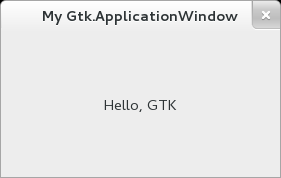ApplicationWindow is a Window subclass that offers some extra
functionality for better integration with Application features.
Notably, it can handle both the application menu as well as the menubar. See
set_app_menu and set_menubar.
This class implements the ActionGroup and ActionMap interfaces, to let you
add window-specific actions that will be exported by the associated Application, together
with its application-wide actions. Window-specific actions are prefixed with the “win.” prefix and application-wide actions are
prefixed with the “app.” prefix. Actions must be addressed with the prefixed name when referring to them from a
MenuModel.
Note that widgets that are placed inside a ApplicationWindow can also activate these actions, if they
implement the Actionable interface.
As with Application, the GDK lock will be acquired when processing actions arriving from
other processes and should therefore be held when activating actions locally (if GDK threads are enabled).
The settings gtk_shell_shows_app_menu and
gtk_shell_shows_menubar tell GTK+ whether the desktop environment
is showing the application menu and menubar models outside the application as part of the desktop shell. For instance, on OS X, both
menus will be displayed remotely; on Windows neither will be. gnome-shell (starting with version 3.4) will display the application menu,
but not the menubar.
If the desktop environment does not display the menubar, then ApplicationWindow will automatically show a
MenuBar for it. This behaviour can be overridden with the
show_menubar property. If the desktop environment does not display
the application menu, then it will automatically be included in the menubar or in the windows client-side decorations.
A GtkApplicationWindow with a menubar
GtkApplication *app = gtk_application_new ("org.gtk.test", 0);
GtkBuilder *builder = gtk_builder_new_from_string (
"<interface>"
" <menu id='menubar'>"
" <submenu label='_Edit'>"
" <item label='_Copy' action='win.copy'/>"
" <item label='_Paste' action='win.paste'/>"
" </submenu>"
" </menu>"
"</interface>",
-1);
GMenuModel *menubar = G_MENU_MODEL (gtk_builder_get_object (builder,
"menubar"));
gtk_application_set_menubar (GTK_APPLICATION (app), menubar);
g_object_unref (builder);
// ...
GtkWidget *window = gtk_application_window_new (app);
Handling fallback yourself
A simple example
The XML format understood by Builder for MenuModel
consists of a toplevel `<menu>` element, which contains one or more `<item>` elements. Each `<item>` element contains `
<attribute>` and `<link>` elements with a mandatory name attribute. `<link>` elements have the same content model as `
<menu>`. Instead of `<link name="submenu>` or `<link name="section">`, you can use `<submenu>` or `<section>
` elements.
Attribute values can be translated using gettext, like other Builder content. `<attribute
>` elements can be marked for translation with a `translatable="yes"` attribute. It is also possible to specify message context and
translator comments, using the context and comments attributes. To make use of this, the Builder
must have been given the gettext domain to use.
The following attributes are used when constructing menu items: - "label": a user-visible string to display - "action": the prefixed name
of the action to trigger - "target": the parameter to use when activating the action - "icon" and "verb-icon": names of icons that may be
displayed - "submenu-action": name of an action that may be used to determine if a submenu can be opened - "hidden-when": a string used
to determine when the item will be hidden. Possible values include "action-disabled", "action-missing", "macos-menubar".
The following attributes are used when constructing sections: - "label": a user-visible string to use as section heading -
"display-hint": a string used to determine special formatting for the section. Possible values include "horizontal-buttons". -
"text-direction": a string used to determine the TextDirection to use when
"display-hint" is set to "horizontal-buttons". Possible values include "rtl", "ltr", and "none".
The following attributes are used when constructing submenus: - "label": a user-visible string to display - "icon": icon name to display
Example: ApplicationWindow:

public class MyApplication : Gtk.Application {
public MyApplication () {
Object(application_id: "testing.my.application",
flags: ApplicationFlags.FLAGS_NONE);
}
protected override void activate () {
// Create the window of this application and show it
Gtk.ApplicationWindow window = new Gtk.ApplicationWindow (this);
window.title = "My Gtk.ApplicationWindow";
window.set_default_size (400, 400);
Gtk.Label label = new Gtk.Label ("Hello, GTK");
window.add (label);
window.show_all ();
}
public static int main (string[] args) {
MyApplication app = new MyApplication ();
return app.run (args);
}
}
valac --pkg gtk+-3.0 Gtk.ApplicationWindow.vala
